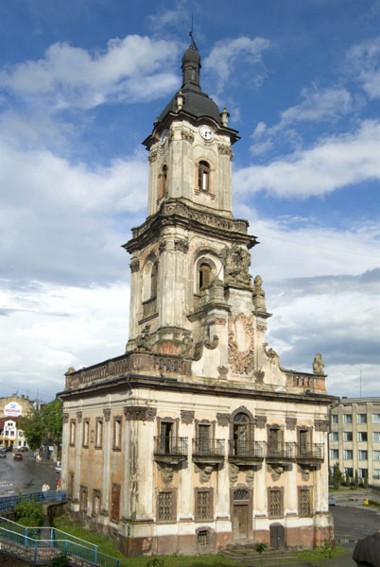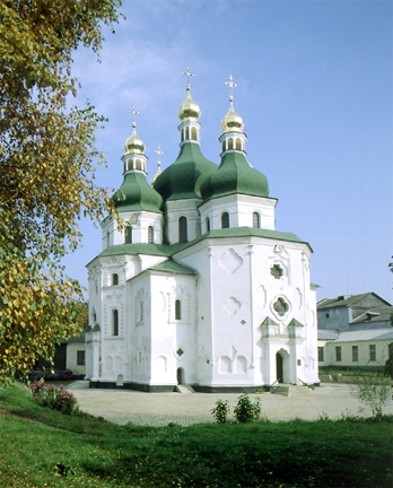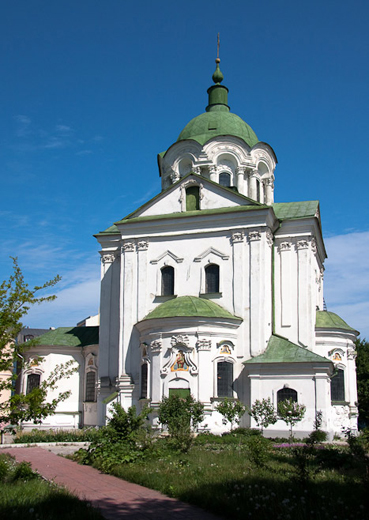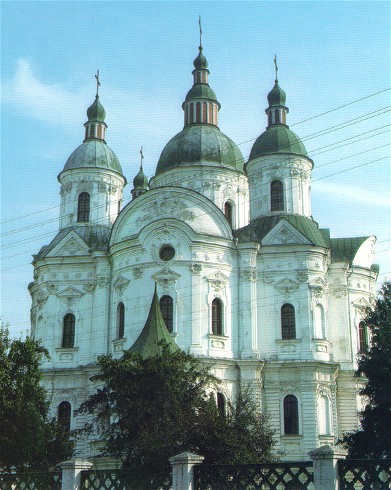Baroque
Baroque. A movement in art that originated in Italy at the end of the Renaissance in the 16th century and spread throughout Europe in the 17th century. The baroque period was a period of grand projects and complex ideas and designs, which gave rise to artistic forms that were intended to lift the spectator above daily existence to lofty and esoteric experience.
The baroque in art and architecture. The works of the period, particularly the architectural works, are marked by rich, flamboyant forms, filled with pathos and a striving for the supernatural and spiritual. In baroque architecture, luxuriant, decorative portals, fronts, and gates, overloaded with unrestrained ornamentation, are common.
In Ukraine the baroque style emerged during the Cossack period and assumed some distinctive features. For this reason it is known as the Ukrainian baroque or the Cossack baroque (end of the 17th to the beginning of the 18th century). Ukrainian baroque architecture, in contrast to the predominantly decorative style of Western Europe, was more constructivist, more moderate in ornamentation, and simpler in form. Numerous examples of church and secular architecture in the Ukrainian baroque have survived: the buildings of the Kyivan Cave Monastery; Zaborovsky Gate near the Saint Sophia Cathedral in Kyiv; the plaster decorations of the Dormition Cathedral of the Kyivan Cave Monastery; the church of Adam Kysil in Nyskynychi in Volhynia; the palaces in Zbarazh, Berezhany, and Bar; the regimental chancellery from Ivan Mazepa's period in Chernihiv; Danylo Apostol's residence and the Transfiguration Church in Velyki Sorochyntsi; and many others. The carvings of the baroque period are represented by such examples as the Bohorodchany iconostasis from the Maniava Hermitage and the iconostases of the main church of the Kyivan Cave Monastery and Saint Michael's Golden-Domed Monastery in Kyiv. The best examples of baroque painting are the church paintings in Holy Trinity Church of the Kyivan Cave Monastery, Paradise in the Church of the Elevation of the Cross of the Kyivan Cave Monastery, as well as iconostases and portraits. During the period of the Ukrainian baroque, engraving underwent rapid development. It utilized a complex system of symbolism, allegories, heraldic signs, and sumptuous ornamentation. In the applied arts and in ornamentation folk motifs were used, giving the ornamentation a particular originality.
The baroque in literature. The main features of the literary style known as baroque are a great emphasis on originality and an overabundance of stylistic devices, particularly metaphors, hyperboles, and antitheses. The purpose of a literary work was to move the reader and to evoke strong emotions in him/her. The baroque world view combined the religiosity of the Middle Ages with the ideas of the Renaissance (the interest in nature, history, and the individual). Literature flourished during the Ukrainian baroque period. Baroque literature began in the first quarter of the 17th century with Meletii Smotrytsky, Kyrylo Stavrovetsky-Tranquillon, and partly even Ivan Vyshensky and ended with the close of the 18th century (Hryhorii Skovoroda). In the mid-17th century (the period known as late baroque), the number and refinement of the stylistic devices increased. Ukrainian baroque is peculiar in that the religious works created in the period outnumbered the secular works. The latter consisted, and only partly at that, of verse poetry, epos, tales, and historical chronicles, while sermons, dramas, and treatises remained almost exclusively religious. This was owing to the fact that writers at the time were mostly members of the clergy and lay patrons were few, that there were no secular schools of higher learning, and that certain circles of Ukrainian readers turned to Latin or Polish literature for their literary needs. These conditions led to an emphasis on religious works among both the Greek Catholics and the Orthodox; for example, Ipatii Potii's Bohohlasnyk (a religious songbook), Ioanikii Galiatovsky's and Antin Radyvylovsky's sermons, and Dymytrii Tuptalo's menaion Chet'ï-Mineï (Monthly Readings). The literary language of the period lacked any set norms, since there was no authoritative intellectual center. The language of the church was the Ukrainian redaction of Church Slavonic. The language of non-religious works absorbed some foreign, mainly Polish, elements. Each author determined what elements of the vernacular or foreign languages he would use. But there were secular works written in Church Slavonic and religious works written almost in the vernacular (Havrylo Dometsky). In the 18th century various elements of Russian entered the literary language. The literature of the Ukrainian baroque had a great influence on Russian literature from the first third of the 17th century up to the mid-18th century. Russian church language changed under the influence of Ukrainian Church Slavonic. Ukrainian baroque literature also had an influence on the Southern Slavs (Mykhail Kozachynsky) and left some traces in Polish literature.
BIBLIOGRAPHY
Pavlutskii, G. Drevnosti Ukrainy (Moscow 1905)
Lukomskii, G. ‘Ukrainskoe barokko,’ Apollon, 3 (Saint Petersburg 1911)
Ernst, F. Ukraïns’ke mystetstvo 17–18 vv. (Kyiv 1918)
Hutsalo, O. ‘Starodubs’ke barokko,' Zbirnyk Sektsiï mystetstva untk (Kyiv 1920)
Sichyns’kyi, V. Styli (Prague 1926)
Mańkowski, T. Lwowskie kościoły barokowe (Lviv 1932)
Tytarenko, S. ‘Ukraïns’ke barokko,’ Arkhitektura Radians’koï Ukraïny, 8 (Kyiv 1940)
Chyzhevs’kyi, D. Ukraïns’ka barokova literatura: Narysy, parts 1–3 (Prague 1941–4)
———, Poza mezhamy krasy (New York 1952)
Sichyns’kyi, V. Istoriia ukraïns’koho mystetstva. Arkhitektura, 1–2 (New York 1956)
Narysy istoriï arkhitektury URSR, 2 vols (Kyiv 1957–64)
Logvin, G. Ukrainskoe iskusstvo X–XVIII vv. (Moscow 1963)
Istoriia ukraïns’koho mystetstva, 3 (Kyiv 1968)
Lohvyn, H. Po Ukraïni (Kyiv 1968)
Radians’ke literaturoznavstvo, 1970, no. 10
Čyževs’kyj, D. A History of Ukrainian Literature (Littleton, Colo 1975)
Kostiuk, O.; Fedoruk, O. (eds). Ukraïns’ke barokko ta ievropeis’kyi kontekst (Kyiv 1991)
Makarov, A. Svitlo ukraïns’koho baroko (Kyiv 1994)
Shevchuk, Valerii. Muza roksolians’ka: Ukraïns’ka literatura XVI–XVIII stolit’ u dvokh knyhakh (Kyiv 2004–2005)
Dmytro Chyzhevsky, Volodymyr Sichynsky
[This article originally appeared in the Encyclopedia of Ukraine, vol. 1 (1984).]

 (1730-40).jpg)
 (1730-40).jpg)
 (1730-40).jpg)

 view.jpg)



.jpg)